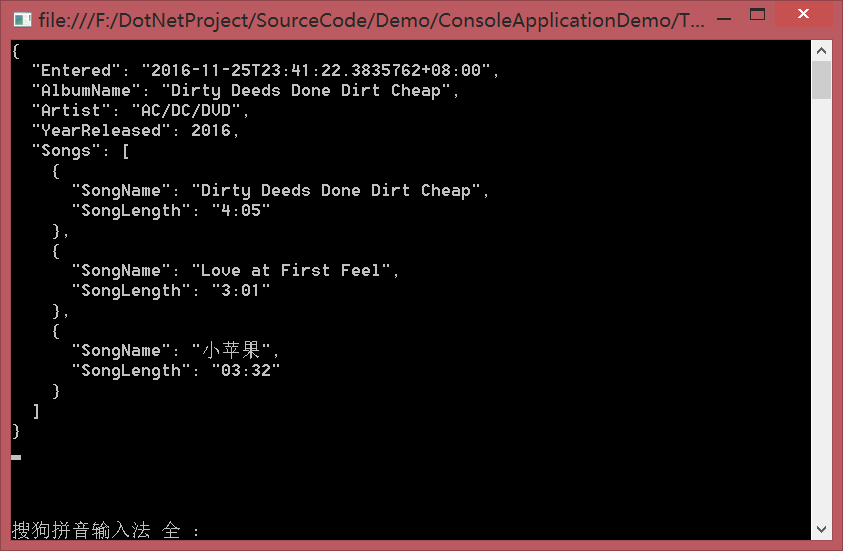常用的一个简单方法
1 string jsonText = "{"zone":"海淀","zone_en":"haidian"}"; 2 JObject jo = (JObject)JsonConvert.DeserializeObject(jsonText); 3 string zone = jo["zone"].ToString(); 4 string zone_en = jo["zone_en"].ToString();
通过JArray和JObject来创建一个音乐专辑结构的一个示例:
1 //Newtonsoft.Json.Linq.JObject jsonObject = new Newtonsoft.Json.Linq.JObject {{"Entered", DateTime.Now}}; 2 3 Newtonsoft.Json.Linq.JObject jsonObject = new Newtonsoft.Json.Linq.JObject(); 4 5 jsonObject.Add("Entered", DateTime.Now); 6 7 dynamic album = jsonObject; 8 9 album.AlbumName = "Dirty Deeds Done Dirt Cheap"; 10 album.Artist = "AC/DC/DVD"; 11 album.YearReleased = DateTime.Now.Year; 12 13 album.Songs = new Newtonsoft.Json.Linq.JArray() as dynamic; 14 15 dynamic song = new Newtonsoft.Json.Linq.JObject(); 16 song.SongName = "Dirty Deeds Done Dirt Cheap"; 17 song.SongLength = "4:05"; 18 album.Songs.Add(song); 19 20 song = new Newtonsoft.Json.Linq.JObject(); 21 song.SongName = "Love at First Feel"; 22 song.SongLength = "3:01"; 23 album.Songs.Add(song); 24 25 song = new Newtonsoft.Json.Linq.JObject(); 26 song.SongName = "小苹果"; 27 song.SongLength = "03:32"; 28 album.Songs.Add(song); 29 30 Console.WriteLine(album.ToString()); 31 32 Console.ReadLine();
以上代码最重要的是没有明确指定类型,便可将动态对象进行JSON序列化,而JObject对象只是接收数据,具体结构通过动态语言在运行时生成,这意味着此代码可以在运行时被编译,从而体现动态语言的优势。序列化的结果如下图所示:

1 //Newtonsoft.Json.Linq.JObject jsonObject = new Newtonsoft.Json.Linq.JObject {{"Entered", DateTime.Now}}; 2 Newtonsoft.Json.Linq.JObject jsonObject = new Newtonsoft.Json.Linq.JObject(); 3 jsonObject.Add("Entered", DateTime.Now); 4 dynamic album = jsonObject; 5 6 album.AlbumName = "非主流歌曲"; 7 8 foreach (var item in jsonObject) //循环输出动态的值 JObject(基类为JContainer、JObject和JArray)是一个集合,实现了IEnumerable接口,因此你还可以轻松地在运行时循环访问 9 { 10 Console.WriteLine(item.Key + "的值为:" + item.Value.ToString()); 11 }

JObject.Parse()和JArray.Parse()方法导入JSON格式,JToken结构支持Parse()和Load()方法,这两个方法可以分别从字符串或各种流读取JSON数据。JValue包括最核心的JSON 解析能力,支持将字符串转化为我们熟悉的动态对象。将JSON字符串转换为成JObject对象,并强制转换为动态类型。
1 var jsonString = @"{""Name"":""小苹果"",""Company"":""韩国公司"", ""Entered"":""2016-11-26 00:14""}"; 2 3 dynamic json = Newtonsoft.Json.Linq.JToken.Parse(jsonString) as dynamic; 4 5 string name = json.Name; 6 string company = json.Company; 7 DateTime entered = json.Entered; 8 Console.WriteLine("name:" + name); 9 Console.WriteLine("company:" + company); 10 Console.WriteLine("entered:" + entered); 11 12 Console.ReadLine();

将JObject和JArray实例映射到一个强类型的对象,所以你可以在同一段代码中混合书写动态和静态类型
1 string jsonString1 = @"[{""Name"":""小苹果"",""Age"":""20""},{""Name"":""演员"",""Age"":""2""}]"; 2 Newtonsoft.Json.Linq.JArray userAarray1 = Newtonsoft.Json.Linq.JArray.Parse(jsonString1) as Newtonsoft.Json.Linq.JArray; 3 List<User> userListModel = userAarray1.ToObject<List<User>>(); 4 foreach (var userModel1 in userListModel) 5 { 6 Console.WriteLine("Name:" + userModel1.Name); 7 Console.WriteLine("Age:" + userModel1.Age); 8 } 9 10 Console.WriteLine(""); 11 string jsonString = @"[{""Name"":""小苹果"",""Age"":""20""}]"; 12 Newtonsoft.Json.Linq.JArray userAarray = Newtonsoft.Json.Linq.JArray.Parse(jsonString) as Newtonsoft.Json.Linq.JArray; 13 Newtonsoft.Json.Linq.JObject jObject = userAarray[0] as Newtonsoft.Json.Linq.JObject; 14 User userModel = jObject.ToObject<User>(); 15 Console.WriteLine("Name:" + userModel.Name); 16 Console.WriteLine("Age:" + userModel.Age);
1 public class User 2 { 3 public string Name { set; get; } 4 public int Age { set; get; } 5 }

JSON.NET对动态语言的支持,但也别忘了它对静态类型的强大支持,关于如何序列化和反序列化强类型对象,JsonConvert是一个高级别的静态类,包装更低级别的功能,但你也可以使用JsonSerializer类,该类可以序列化和反序列化各种流
1 UserType album = new UserType() 2 { 3 Type = "普通用户", 4 UserListModel = new List<User>() 5 { 6 new User() 7 { 8 Name="张三", 9 Age = 20 10 }, 11 new User() 12 { 13 Name="李四", 14 Age = 30 15 } 16 } 17 }; 18 19 // serialize to string 20 string json2 = Newtonsoft.Json.JsonConvert.SerializeObject(album, Newtonsoft.Json.Formatting.Indented); 21 Console.WriteLine("序列化结果"); 22 Console.WriteLine(""); 23 Console.WriteLine(json2); 24 25 UserType userType = Newtonsoft.Json.JsonConvert.DeserializeObject<UserType>(json2); 26 Console.WriteLine(""); 27 Console.WriteLine("反序列化:"); 28 Console.WriteLine("Type:"+ userType.Type); 29 Console.WriteLine(""); 30 foreach (var userModel in userType.UserListModel) 31 { 32 Console.WriteLine("Name:"+userModel.Name); 33 Console.WriteLine("Age:" + userModel.Age); 34 }
1 public class UserType 2 { 3 public string Type { get; set; } 4 public List<User> UserListModel { get; set; } 5 } 6 7 public class User 8 { 9 public string Name { set; get; } 10 public int Age { set; get; } 11 }

转自 http://www.cnblogs.com/linJie1930906722/p/6103455.html